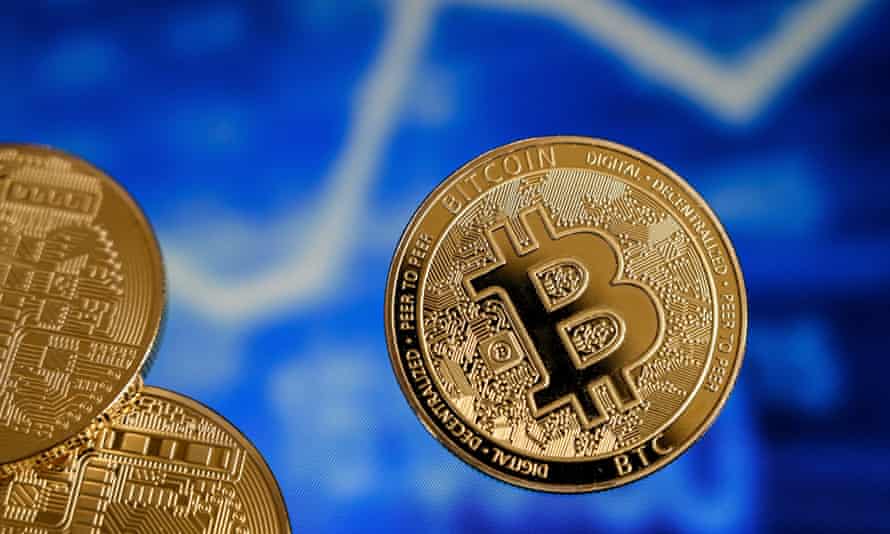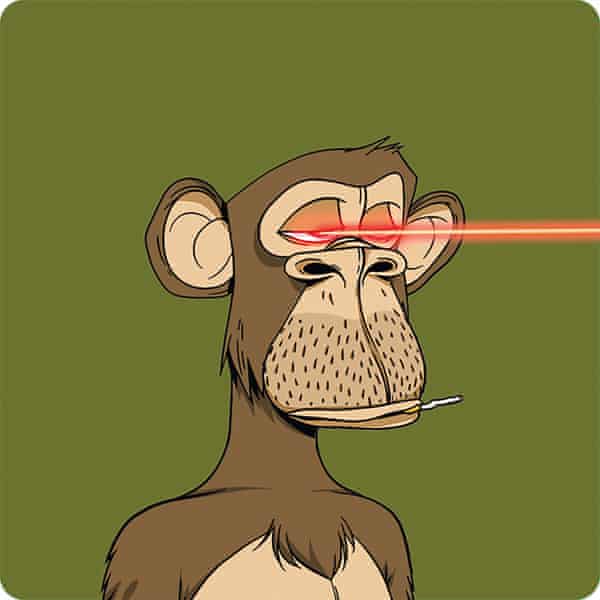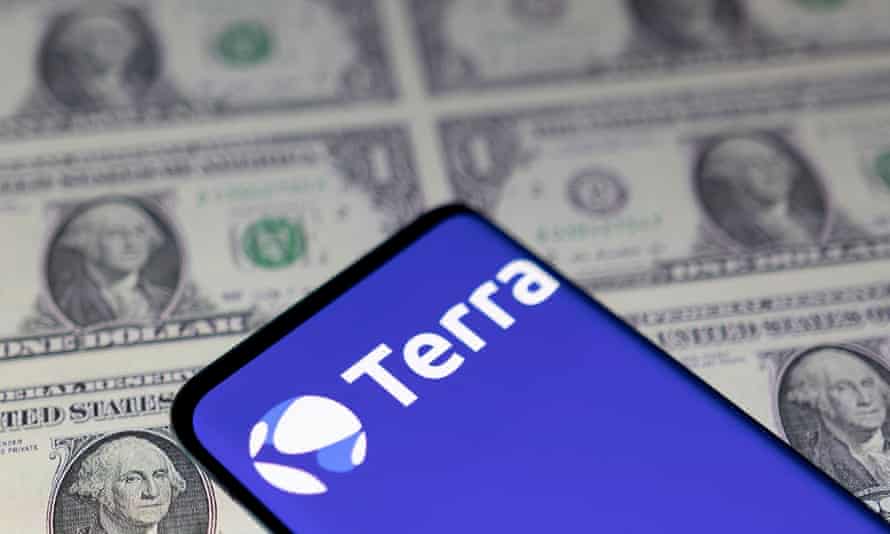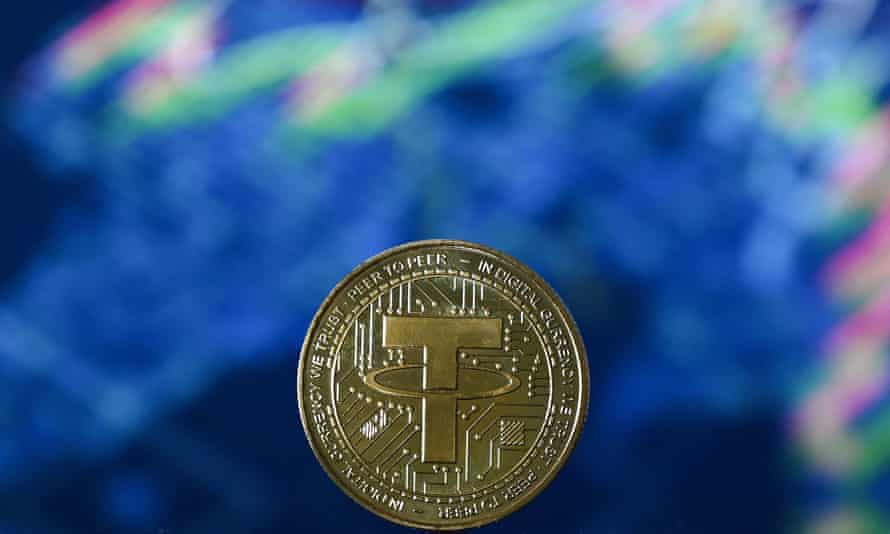Yuri Popovich had watched his neighbours’ houses burn down to the ground in Kyiv and he needed a safe place to put his money. So he did what millions of amateur investors have done in recent years: he turned to cryptocurrency.
“It was impossible and unsafe to store funds in the form of banknotes. There was a big risk of theft, we also had cases of looting. Therefore, I trusted a ‘stable and reliable’ cryptocurrency. Not for the purpose of speculating, but simply to save,” he says.
The digital asset that Popovich chose in April was terra, a “stablecoin” whose value was supposed to be pegged to the dollar.
It collapsed in May, sparking a rout in the cryptocurrency market whose victims include Popovich. He lost $10,000 (£8,200).
Q&A
How crypto works
Show
What is a cryptocurrency?
A cryptocurrency is a decentralised digital asset built on top of a blockchain. The first, and still the largest, cryptocurrency, is bitcoin, and its blockchain is secured by miners using a proof-of-work system. But other cryptocurrencies exist too. Ethereum is the second biggest, and is used as a platform for building other decentralised projects, such as stablecoins, NFTs and shitcoins.
What is a blockchain?
A blockchain is the decentralised ledger that tracks the ownership of a cryptocurrency or other digital asset. New transactions are added on to the end of the blockchain, and using cryptography contain a record of every previous transaction. There is no one “official” blockchain, but the network as a whole is kept consistent through a consensus algorithm like proof of work.
What is proof of work?
Proof of work is the consensus algorithm used to secure bitcoin, ethereum and many other large cryptocurrencies. It asks “miners”, who run the computer nodes that make up the physical infrastructure of the blockchain network, to effectively burn electricity to generate digital raffle tickets. Every 10 minutes, one of those raffle tickets wins the prize – a reward of cryptocurrency, and the right to verify the next block on the blockchain. The system means that it is very expensive to attack a cryptocurrency head-on: you need to spend more electricity than every other miner put together.
What is a miner?
A miner is the person running a cryptocurrency node. They use specialised computers, called mining rigs, to perform a specific mathematical function called “hashing”. The network treats the results of these hashes as lottery tickets, and every 10 minutes one miner is declared the winner. For bitcoin miners, that prize is currently $125,000, which incentivises the bitcoin network as a whole to consumer around 130TWh a year, around the electricity usage of Argentina.
What is ethereum?
The most important successor to bitcoin, ethereum is described by its backers as a “world computer”: as well as simple transactions, users can create “smart contracts”, small programs that operate on the network. Those smart contracts can be chained together to create whole “decentralised apps”, which operate without any individual computer being in charge of them, and they can also be used to create new cryptocurrencies and digital assets that live on the ethereum blockchain, rather than needing more miners and a new network.
What is a stablecoin?
A stablecoin, such as tether, USDC, or UST, is a particular type of cryptocurrency intended to have a fixed value. They occupy an important role in the crypto economy, since they let people “cash out” of risky bets without going through the hassle of converting money back to conventional cash. But keeping the value stable is hard: it requires a large centralised organisation to operate like a bank, keeping a lot of reserves on hand and spending them to stabilise the currency. “Algorithmic” stablecoins, such as UST, also known as terra, have been attempted, but have an unfortunate tendency to enter a “death spiral”, where a crashing value leads to more tokens being created, pushing the value lower.
What is an NFT?
An NFT, or non-fungible token, is a type of digital asset that can be traded like a cryptocurrency, but isn’t “fungible” like money: one NFT is distinct from another. Early NFTs resembled collectibles, like digital football stickers, or were used to trade artworks, but the lack of any functional utility led to a boom and bust of the sector in 2021. The latest generation of NFTs try to focus on “utility”, offering membership benefits or technological advantages to holders.Body
Popovich says his losses were “devastating”, although donations from sympathetic onlookers on social media have helped make up some of the shortfall. He says: “I stopped sleeping normally, lost 4kg, I often have headaches and anxiety.”
Popovich is one of many experiencing the deep chill of the current crypto winter, more than four years after the market’s cornerstone, bitcoin, marked the first digital freeze by tumbling from its then peak.
It went on a long tear after that but it has come to a juddering halt, with bitcoin falling below the $20,000 mark at one point this month – far below its peak of nearly $69,000 which it hit last November.
The fall has been sharp and spectacular: an overall market that was estimated to be worth more than $3tn barely six months ago is now worth less than $1tn.
Crypto boom: a new digital economy …
The beginnings of the latest crypto boom held all the hallmarks of being another instance of the so-called “Robinhood economy”, named after the popular American stock trading app.
Bored white collar workers, stuck at home because of pandemic lockdowns but awash with disposable income, turned to day trading as a way to pass the time. Subscribers to the WallStreetBets forum on the popular online discussion site Reddit doubled over the course of 2020 and then quadrupled in the first month of 2021, as a small army of retail investors flooded into assets as varied as the then bankrupt car rental company Hertz, the troubled video game retailer GameStop and the electric car manufacturer Tesla, pushing the latter from $85 at the beginning of the pandemic to a high of $1,243 towards the end of 2021.
Cryptocurrencies also benefited from the surge in day trading. Bitcoin soared from a low of $5,000 in March 2020 to more than $60,000 a year later. The currency has had that sort of precipitous increase before: in 2017, it had risen 20-fold, to its then peak of $19,000. But in the latest boom, ethereum, the number two cryptocurrency, had an even more impressive climb, from just $120 to a high of almost $5,000 in 2021.

Cryptocurrency is the name for any digital asset that works like bitcoin, the original cryptocurrency, which was invented in 2009. There is a “decentralised ledger”, which records who owns what, built into a “blockchain”, which secures the whole network by ensuring transactions are irreversible once made. In the years since then, a dizzying amount of variations have arisen, but the core, the blockchain concept, is remarkably stable, in part because of the social implications of truly decentralised networks being immune to government oversight or regulation.
Where, 10 years ago, people simply spoke of trading in bitcoin, the space has ballooned. As well as cryptocurrencies themselves, , the sector has developed in a complex ecosystem.
It encompasses Web3, a broader selection of apps and services built on top of cryptocurrencies, DeFi, an attempt to bootstrap an entire financial sector out of code rather than contracts, and non-fungible tokens (NFTs), which use the same technology as cryptocurrencies to trade in objects rather than money.
The flood of money washing into the world of crypto did more than simply inflate the paper wealth of pre-existing shareholders. Instead, it led to a surge of interest in, and funding for, the vast array of projects that aimed to capitalise on the underlying technology of cryptocurrencies.

For a generation of new investors, the “decentralised finance” opportunities of the sector were appealing. Built on top of the “programmable money” of the ethereum cryptocurrency, the “DeFi” [decentralised finance] sector is an attempt to expand bitcoin’s anti-establishment ethos to cover the entire economy.
Take the comparatively small sector of the crypto market known as NFTs.
A product dating back to 2014, NFTs take the tech used to create cryptocurrencies, but let creators link unique assets to the blockchain, instead of money-like currencies.
That means NFTs can be traded that represent works of art, virtual collectibles, or even function as tickets to events or membership of clubs. And like cryptocurrencies, they can be bought or sold in open exchanges, held pseudonymously, and packaged up or securitised in complex financial instruments.

A boom within a boom, individual NFTs sold for silly amounts of money in mid-2021.
One token, representing years of work by the digital artist Beeple, sold for $69m; another, linked to the first tweet sent by the Twitter founder Jack Dorsey, was bought for $2.9m. Individual NFTs in the Bored Ape Yacht Club collection – the most consistently desired examples of “profile pic” NFTs, designed to be used as pre-packaged online identity – regularly sold for $1m-$3m apiece.
But by the beginning of 2022, the NFT bubble appeared to have already popped. “Floor” prices for large NFT collections had plummeted, and, while many large NFT acquisitions have stayed in private collection, those that have been put back on the market have fared poorly: the Dorsey tweet was withdrawn from sale after achieving a top bid of just $14,000.
And then: the crash …
The crypto crisis has played out against the backdrop of wider market problems, as fears over the Ukraine conflict, rising inflation and higher borrowing costs stalk investors. Some market watchers play down the prospect of a crypto crash triggering serious problems elsewhere in the financial markets or the global economy. The total value of all cryptocurrencies is about $1tn currently (with bitcoin accounting for about 40% of the total), which compares with approximately $100tn for the world’s stock markets.
Since November the value of all cryptocurrencies has fallen from $3tn, meaning that $2tn worth of wealth has been wiped out, with no serious knock-on effects to the broader stock market – so far.
Teunis Brosens, the head economist for digital finance at the Dutch bank ING, says the traditional financial system is relatively well shielded because established banks – the cornerstones of the financial world that buckled in 2008 – are not exposed to cryptocurrencies because they do not hold digital assets on their balance sheets, unlike during the financial crisis when they held toxic debt products related to the housing market.
“What has happened in the crypto market has caused great losses for some investors and it’s all very painful and not something I want to downplay,” he says. “But it would be overplaying the role that crypto currently has in the economic and financial system if you were to think there could be systemic consequences for the wider financial system or even a global recession directly caused by crypto assets.”
To date, the turmoil has been limited to the crypto sector. Digital assets have been hit by some of the same economic issues that have affected the wider global economy and stock markets. Bitcoin and other cryptocurrencies have been affected by concerns over rising inflation and the ensuing increases in interest rates by central banks, which has made risky assets less attractive to investors. This meant that as stock markets declined, so too did crypto assets.

But the collapse last month of terra also hit confidence in cryptocurrencies. In June, a cryptocurrency lender, Celsius, was forced to stop customer withdrawals. And a hedge fund that made big bets on the crypto markets slid towards liquidation.
Crypto investors and firms that had made bets on the crypto market using digital assets as collateral were forced into a selling spree.
Kim Grauer, the head of research at the cryptocurrency data firm Chainalysis, says: “It was a combination of the stock market plus the kind of excessive reaction that is typical of crypto markets because of these cascading liquidations. In this case the key event was terra.”
She added: “Crypto is not going away. And it has experienced crashes more severe than this crash.”
Regulators and various government agencies are looking closely. Harry Eddis, the global co-head of fintech at Linklaters, a London-based law firm, says recent events in the crypto asset market will strengthen regulators’ determination to rein in the industry.
“I think it will certainly stiffen the sinews of the regulators in saying that they’re more than justified in regulating the industry, because of the obvious risks with a lot of the crypto assets out there,” he says.
In the UK, the financial watchdog continues to expand safeguards on crypto products. Its latest proposals on marketing crypto products to consumers could lead to significant restrictions on crypto exchanges operating in the UK. Consumers reported 4,300 potential crypto scams to the Financial Conduct Authority’s website over a six-month period last year, far ahead of the second place category, pension transfers, which had 1,600 reports. The FCA has 50 live investigations, including criminal inquiries, into companies in the sector.

The terra collapse has also heightened regulatory concerns about stablecoins, because they are backed by traditional assets and therefore could pose a risk to the wider financial system. In the UK, the Treasury wants a regime in place for dealing with a stablecoin collapse, saying in May that a terra-like failure could endanger the “continuity of services critical to the operation of the economy and access of individuals to their funds or assets”.
“Even just the top three stablecoins hold reserves totalling $140bn in traditional assets, much of this being in commercial paper and US treasuries. A run on redemptions of the largest coin (tether) could destabilise the entire crypto asset system and spill over into other markets,” says Carol Alexander, the professor of finance at University of Sussex Business School.
Elsewhere, the EU is drawing up a regulatory framework for crypto assets with the aim of introducing it by 2024, while in the US Joe Biden has signed an executive order directing the federal government to coordinate a regulatory plan for cryptocurrencies including ensuring “sufficient oversight and safeguard against any systemic financial risks posed by digital assets”. The Federal Trade Commission, the US consumer watchdog, says 46,000 people have lost more than $1bn to crypto scams since the start of 2021.
In general, regulators have been talking tough about cryptocurrencies. The chair of the FCA has called for “strong safeguards” to be put in place for the crypto market, while the head of the US financial regulator has warned consumers about crypto products promising returns that are “too good to be true”, while Singapore has said it will be “brutal and unrelentingly hard” on misbehaviour in the crypto market.
‘I’m sure crypto will bubble again …’
Where crypto goes from here is an unanswerable question. For proponents, such as Changpeng Zhao, the multibillionaire owner of the Binance cryptocurrency exchange, the sector is sure to recover – though it might take some time. “I think given this price drop … it will probably take a while to get back,” he told the Guardian last week. “It probably will take a few months or a couple of years.”
For sceptics, however, the plummet could be a lasting wound. “Bitcoin will be around for decades,” says David Gerard, author of Attack of the 50-Foot Blockchain. “All you need is the software, the blockchain and two or more enthusiasts. Unless there’s new stringent regulation, I’m sure crypto will bubble again. But if there’s a genuine consumer bubble, it may not reach the heights of this one. The 2021-22 bubble made it to the Super Bowl. As many a dotcom found out 20 years ago, there’s nowhere to go from there – you’ve reached every consumer in America.”

But one thing both sides agree on is that the dividing line between “survivable downturn” and “cryptoapocalypse” is likely to involve neither bitcoin nor ethereum, but the third biggest cryptocurrency: a stablecoin called tether.
Stablecoins are a foundational part of the crypto ecosystem. Their value is fixed to that of a conventional currency, allowing users to cash out of risky positions without going through the rigamarole of a bank transfer, and enabling crypto-native banks and DeFi establishments to work without taking on a currency risk.
In essence, stablecoins function like the banks of the crypto economy, allowing people to park their money safely in the knowledge that it isn’t exposed to wider risk. Which means that when a stablecoin collapses, it has a very similar effect to a bank failure: money disappears across the ecosystem, liquidity dries up, and other institutions begin to fail in a domino effect.
The beginning of the latest crisis in crypto was sparked by exactly that: the failure of the terra luna stablecoin.
The algorithmic checks and balances put in place to keep it stable broke – triggering a death spiral.
And so on 9 May, a stablecoin called UST “depegged”, dropping from $1 to $0.75 in a day, and then falling further, and further and further. Within four days, the luna blockchain was turned off entirely, the project declared dead.

A domino effect took out other crypto establishments. Some of the “contagion” has been prevented, in part through massive loans made by Alameda Ventures, the investment arm of 30-year-old crypto billionaire Sam Bankman-Fried’s empire. Drawing comparisons to JP Morgan in the panic of 1907, “SBF” has stepped in to support the crypto bank Voyager and the embattled exchange BlockFi, and been loudly calling for support from others.
Unlike terra, tether is a “centralised” stablecoin, maintaining its value through reserves which, the company says, are always redeemable one-to-one for a tether token. The model means it can’t enter a “death spiral” like terra, but also means the stability of the token is entirely a function of how much one trusts tether to actually maintain its reserves.
That trust isn’t a sure thing. Tether once claimed to hold all its reserves in “US dollars”, a claim that the New York attorney general’s office concluded in 2021 was “a lie”.
Tether, and Bitfinex, a bitcoin exchange that shares an executive team with, but is legally distinct from, Tether, “recklessly and unlawfully covered-up massive financial losses to keep their scheme going and protect their bottom lines,” Letitia James, the New York attorney general, said at the time.

The two companies had transferred money back and forth to cover up insolvency, she said, and had failed to ensure tether was “fully backed at all times,” the investigation concluded.
“Tether has been the timebomb under the market since 2017,” says Gerard. “It has reduced its market cap by 15bn USDT in the last month, and has claimed that these are redemptions, or a reduction in their holdings of ‘commercial paper’,” she says, referring to one of the key assets that Tether uses on its balance sheet: commercial paper, short-term debt issued by banks and corporations to cover immediate funding needs.
Tether, for its part, remains extremely bullish – and has even suggested it might publish a formal audit of its reserves, something it said was “months away” in August 2021.
In late June, Tether announced another expansion: the introduction of the first GBP stablecoin. “We believe that the UK is the next frontier for blockchain innovation and the wider implementation of cryptocurrency for financial markets,” says Paolo Ardoino, the chief technology officer of Tether and Bitfinex.
“Tether is ready and willing to work with UK regulators to make this goal a reality.”
More regulation, and further market volatility, are a given.
Popovich says he is still receiving donations. “I’m extremely embarrassed. Yesterday an anonymous person sent me $50 in the form of cryptocurrency. And I’ve never borrowed anything from anyone in my life. I’m scared and restless.”
 Top Naija News: Nigerian News, Breaking News Nigeria and World News Top Naija News is a daily news publication in Nigeria, delivering the latest breaking news in Nigeria and around the world.
Top Naija News: Nigerian News, Breaking News Nigeria and World News Top Naija News is a daily news publication in Nigeria, delivering the latest breaking news in Nigeria and around the world.



